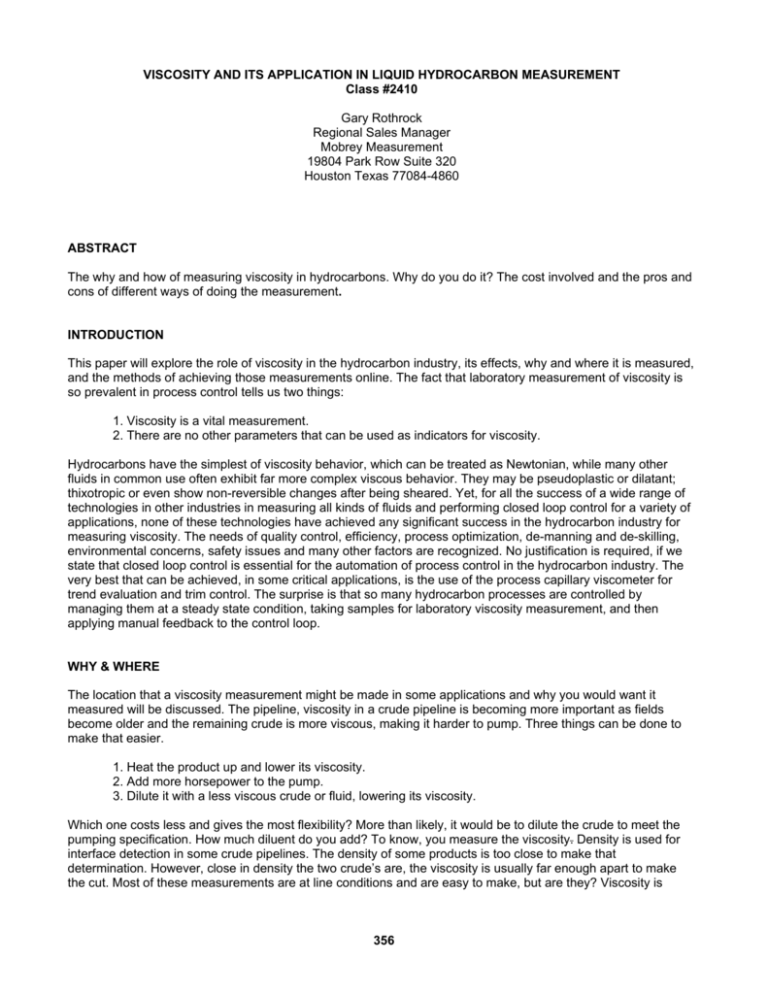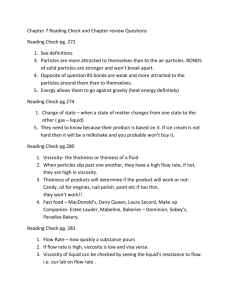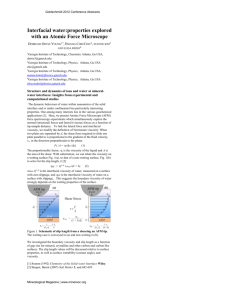Viscosity - Integrated Sensing Systems
advertisement

VISCOSITY AND ITS APPLICATION IN LIQUID HYDROCARBON MEASUREMENT Class #2410 Gary Rothrock Regional Sales Manager Mobrey Measurement 19804 Park Row Suite 320 Houston Texas 77084-4860 ABSTRACT The why and how of measuring viscosity in hydrocarbons. Why do you do it? The cost involved and the pros and cons of different ways of doing the measurement. INTRODUCTION This paper will explore the role of viscosity in the hydrocarbon industry, its effects, why and where it is measured, and the methods of achieving those measurements online. The fact that laboratory measurement of viscosity is so prevalent in process control tells us two things: 1. Viscosity is a vital measurement. 2. There are no other parameters that can be used as indicators for viscosity. Hydrocarbons have the simplest of viscosity behavior, which can be treated as Newtonian, while many other fluids in common use often exhibit far more complex viscous behavior. They may be pseudoplastic or dilatant; thixotropic or even show non-reversible changes after being sheared. Yet, for all the success of a wide range of technologies in other industries in measuring all kinds of fluids and performing closed loop control for a variety of applications, none of these technologies have achieved any significant success in the hydrocarbon industry for measuring viscosity. The needs of quality control, efficiency, process optimization, de-manning and de-skilling, environmental concerns, safety issues and many other factors are recognized. No justification is required, if we state that closed loop control is essential for the automation of process control in the hydrocarbon industry. The very best that can be achieved, in some critical applications, is the use of the process capillary viscometer for trend evaluation and trim control. The surprise is that so many hydrocarbon processes are controlled by managing them at a steady state condition, taking samples for laboratory viscosity measurement, and then applying manual feedback to the control loop. WHY & WHERE The location that a viscosity measurement might be made in some applications and why you would want it measured will be discussed. The pipeline, viscosity in a crude pipeline is becoming more important as fields become older and the remaining crude is more viscous, making it harder to pump. Three things can be done to make that easier. 1. Heat the product up and lower its viscosity. 2. Add more horsepower to the pump. 3. Dilute it with a less viscous crude or fluid, lowering its viscosity. Which one costs less and gives the most flexibility? More than likely, it would be to dilute the crude to meet the pumping specification. How much diluent do you add? To know, you measure the viscosity. Density is used for interface detection in some crude pipelines. The density of some products is too close to make that determination. However, close in density the two crude’s are, the viscosity is usually far enough apart to make the cut. Most of these measurements are at line conditions and are easy to make, but are they? Viscosity is 356 becoming more important as input for the leak detection algorithm in pipelines. A more accurate viscosity measurement means better leak detection. But, how accurate is accurate enough? It is the blending of two products to make a third, is common. This blending is accomplished using a ratio controller and control valves. The ratio is determined by using laboratory measurements of density and viscosity, then back calculating how much of each is necessary to make the third. Of course, the laboratory measurement is at base conditions and the tankage is at another. This also assumes that the two products remain the same all the way throughout the batch and never vary within the batch. A good example of this is the mixing of jet fuel and HFO or MFO for marine fuel. These fuels are stored in tankage, and then depending on the customer’s requirement, are mixed to a viscosity specification at the point of delivery. The mix will not meet the target specification if the ratios incorrect. Getting the mix back can be very hard as it is generally delivered into a barge or ship. Doing an online viscosity measurement would help solve this problem. However, the products do change. How do you track the real referred viscosity? The ship unloading measurement may be improved by online viscosity measurement while at the marine terminal. Compensation for viscosity changes on the turbine meters is well established, but how you measure the viscosity is not. During the unloading of the ship, the viscosity changes and these changes need to be entered into the metering system in real time. A laboratory sample is generally not fast or often enough to give real time results. There are many places that viscosity would be a useful measurement in a petrochemical plant. The bottom on a vacuum tower is sometimes a feedstock to another part of the plant or it could be a product by itself. This other part of the plant wants a consistent feedstock based on viscosity, or the customer has a certain specification in the contract. . Measuring the viscosity and blending in a third product can achieve this control. The output of the vacuum tower is generally thought of as asphalt and the diluent is diesel or HFO. The viscosity measurement is generally referred to a base temperature that is so low that the product is solid at that temperature. So, how do you get a good measurement when the product is solid? You must measure it at a temperature where it is not a solid. How do we do measure viscosity? DIRECT METHOD The best way would be to measure viscosity at the temperature in question by controlling the temperature. It would seem very simple to hold the temperature constant and measure the viscosity at the required temperature, as can be seen from Figure 1. However, many things contribute to getting a good viscosity measurement. A constant flow is also required. A positive displacement pump with a magnetic drive to meet environmental concerns would work well. Properly sized, it would deliver a constant flow, +/- 1%, at the set point over a wide range of viscosities. From experience, the more viscous the fluid, the higher the flow rate needs to be. Perhaps, a variable frequency drive on the motor to the pump would make sense. There may be a need to change set point during calibration to obtain stable readings for the viscometer. In some cases, this can be very cost effective, save time and costs during startup and possibly cost less at installation. 357 FIGURE 1. A BASIC TEMPERTURED CONTROLLED MEASUREMENT SYSTEM The most trouble comes from the temperature control system. As the hydrocarbon flows through the system, its heat coefficient changes causing the heat flow in or out of the heat exchanger to change rapidly. Three-stage temperature control may be needed to maintain the +/- 0.5 °C needed for good measurement. Temperature control is critical in this method of measurement because you are measuring at the temperature in question. Any variation in temperature will be seen as a variation in viscosity. Not shown in Figure 1 is insulation on all pipe work, from the mainline, at the sample point, on the sample lines, at the pump, and past the flow cell where the viscosity measurement has been made. The purpose is to get a representative sample to the viscometer. Remember that temperature has a large effect on viscosity and temperature gradients must be avoided. Experience has shown that hydrocarbons can separate in the line and that a static mixer, immediately upstream of the flow cell, is a good idea. INDIRECT METHOD What if the temperature were not controlled? It may not be possible to make the measurement at the required temperature. The hydrocarbon could be solid at that temperature; Asphalt is quite solid at 60° F, which is a common reference temperature. How are these measurements made? It is measured at one temperature and referred to another. A basic system without temperature control is show in Figure 2. 358 V iscom eter a DENSITY VIS COSITY TEMPE RATURE PRE SURE 12 b c d 7 8 4 1 5 2 0 9 6 3 +/ - CLR EXP i Pump Figure 2. A BASIC NON-TEMPERTURE CONTROLED SYSTEM Referral methods are based around the ASTM D341-93 (1) expression of the temperature viscosity relationship [for viscosity above 2 cSt]: log10 (ν + 0.7) = A – B log10 (T + 273) [Equation 1] Where ν is the Kinematic viscosity [cSt] at temperature T [°C] and A & B are constants which are unique to that sample of oil. The problem is to solve the equation to find the values of A & B, then to calculate the viscosity at the reference temperature. The three methods that are being used in the field for hydrocarbon applications are described here: • The equation method for a single viscosity analyzer • The multi-curve method for a single viscosity analyzer • The dual viscometer method using two viscosity analyzers EQUATION METHOD Equation 1 contains two variables, temperature and Kinematic viscosity, and two constants [A & B] that are unique to that oil sample. Resolution of the equation depends on knowing the kinematic viscosity of the sample at two different temperatures. A single viscometer is desirable for most simple applications. Remember that the equation requires kinematic viscosity and that requires a density measurement at the same time. This first method is based on the assumption that for small changes in oil quality, the value of B remains constant. If B is constant, then the single process viscosity measurement and the corresponding temperature are all that are required to calculate the value of A. With B and A both known, the equation can then be solved for the base viscosity (ies) by substituting the reference temperature(s). Taking a sample to the laboratory and testing that the measured base viscosity and the calculated base viscosity correspond within acceptable limits periodically tests the assumption that B is constant. If not, the laboratory measurement can be used with the corresponding process measurements to determine a new value for B. This method is particularly well suited to closed loop applications where the control actively maintains oil quality and helps to sustain the validity of the assumption. A typical application is quench oil where the viscosity changes only from 2-3 CST at 140°C (process conditions) to between 11-12 cSt at 40°C (the reference conditions) • A complication with quench oil, whether used for thermal cracker control or the less conventional but equivalent distillation control, is that as the temperature increases, the viscosity 359 increases which is contrary to our normal expectation. However, this is due to the change in oil composition that is a direct result of increasing the quench oil temperature. • Viscosity measurement at the operating temperature is therefore more complex than usual if conventional look-up tables or charts are used. However, it is a problem, which is solved in a highly effective manner by the indirect referral equation method. MULTI-CURVE METHOD The multi-curve method uses four representative samples of the oil to “map” the expected range of oil qualities as show in Figure 3. A & B are found for each sample through laboratory evaluation. The process instrument measures the process kinematic viscosity and the corresponding temperature. This temperature is then used in the equation to calculate the equivalent viscosity for each of the reference oil samples using the stored values of A & B. The ratios of the measured viscosity of the process fluid to these viscosities (at the process temperature) are then determined. The stored A & B values are then used to compute the viscosity of each of the oil samples at the base temperature(s). The ratios determined above are then used to derive the base temperature viscosity of the process oil. Laboratory over testing can be used to validate the method and corrections made when necessary. This method is often used for multi product applications such as fuel oil blending where different grades may be blended and where the single equation method is unsuitable. Using heat exchangers to bring the temperature of the sample stream closer to the reference temperatures will normally enhance accuracy of the referral. Errors can be due to instrument measurement error and also due to deviation in oil quality from the quality used to derive A & B values originally. With many processes these errors are small. FIGURE 3. VISCOSITY VS. TEMPERTURE FOR FOUR SAMPLES DUAL VISCOMETER METHOD An additional method has been developed which is suitable for applications where no assumptions can be permitted or where laboratory over checking is not appropriate. It is comprised of two viscometers in series and separated by a heat exchanger. The temperature of the sample is changed as it emerges from one instrument and enters the next. Thus, the viscosity is measured at two 360 separate temperatures. From these measurements the true values of both A & B for this sample of oil at the viscosity analyzers can be calculated and consequently the base viscosity (ies) can also be determined. Because of its independence of oil quality, this method is valued where feedstock’s can vary in quality and where high accuracy is valued. This is also a valuable method where access to laboratory testing is limited. Typical examples include crude oil pipeline viscosity blending control, heavy fuel oil viscosity control and many other critical processes. A simple dual system is show in Figure 4, this example has an upstream heat exchanger to adjust the systems overall temperature. FIGURE 4. A BASIC DUAL VISCOMETER SYSTEM WITH AN HEAT EXCHANGER CONCLUSION If the viscosity at the base temperature cannot be measured [direct method], all of these referral methods [indirect methods] have the ability to provide the base kinematic viscosity at two or more reference temperatures continuously. They can be used not just for trim control, but also for direct closed loop control in real time. The large amounts of money and time spent are indicators that industry considers viscosity measurement important and necessary. Currently, viscosity measurements are still performed in the laboratory. However, online viscometers are being installed everyday for online viscosity measurement, as online viscometers are coming into common use. Installation practices must be rigorous enough to achieve overall system accuracy. The route from line conditions to base conditions is well defined and understood. Care must be taken that the method selected and the viscometer used will yield the required accuracy. Systems should be able to read within 1 cSt over a wide range of viscosities. 361 NOMENCLATURE Viscosity - Viscosity is the resistance of a fluid to flow under the influence of an applied force (i.e. shear). Density – The weight per unit volume. Dynamic Viscosity – Viscosity measured without regard to density. Sometimes called Absolute viscosity [cP]. Kinematic Viscosity – Viscosity measured with regard to density [cSt]. Centipoise – A unit of measure of viscosity without a density coefficient [cP]. Centi Stokes – A unit of measure of viscosity with a density coefficient [cSt]. Line Viscosity – Viscosity measured at line conditions i.e. line temperature and line pressure. Base / Referred Viscosity – Viscosity measured or calculated at a base / referred conditions i.e. 15 °C & 1 bar. Direct Measurement of Viscosity – The measure of viscosity at the base temperature. HFO - High density fuel oil. Indirect Measurement of Viscosity – The measurement of viscosity at one [or two] Temperatures and referring it to another temperature using an equation. ASTM D341- An equation for calculating the viscosity at a Base / Referred temperature using viscosity at two other temperatures. MFO - Medium density fuel oil. Newtonian Fluid – A fluid in which the viscosity remains the same at different shear rates. REFERENCES 1. ASTM Book of Standards, Volume 05.01, 1998 2. API Standard 55.4 3. API Standard 55.5 362





